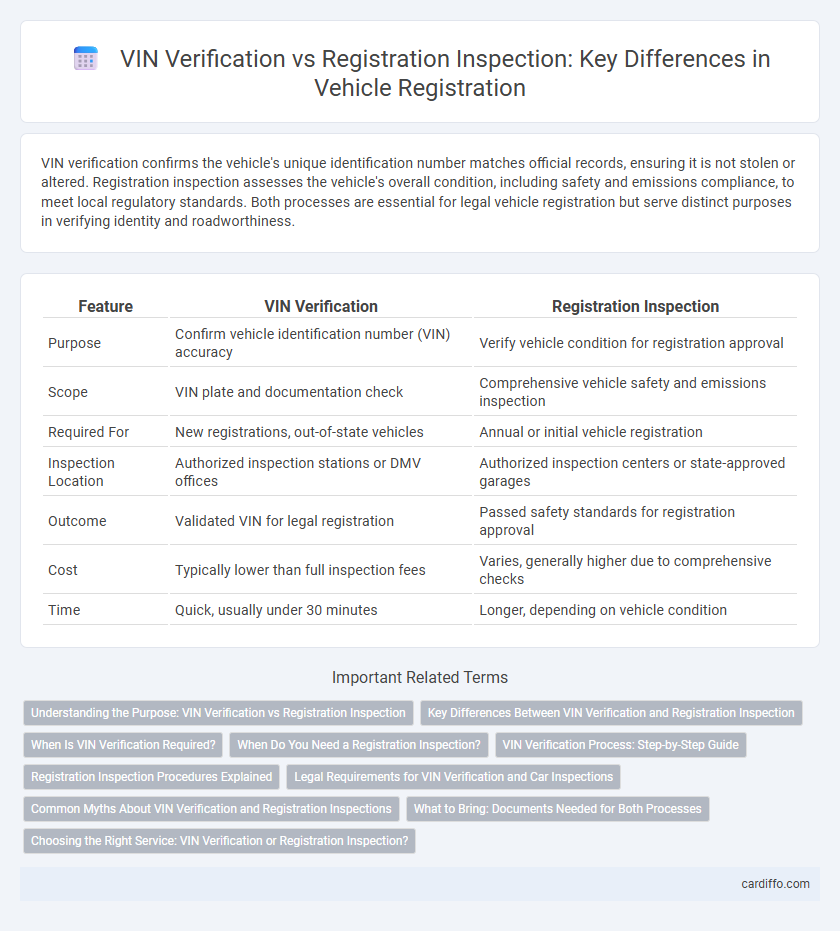VIN verification confirms the vehicle's unique identification number matches official records, ensuring it is not stolen or altered. Registration inspection assesses the vehicle's overall condition, including safety and emissions compliance, to meet local regulatory standards. Both processes are essential for legal vehicle registration but serve distinct purposes in verifying identity and roadworthiness.
Table of Comparison
| Feature | VIN Verification | Registration Inspection |
|---|---|---|
| Purpose | Confirm vehicle identification number (VIN) accuracy | Verify vehicle condition for registration approval |
| Scope | VIN plate and documentation check | Comprehensive vehicle safety and emissions inspection |
| Required For | New registrations, out-of-state vehicles | Annual or initial vehicle registration |
| Inspection Location | Authorized inspection stations or DMV offices | Authorized inspection centers or state-approved garages |
| Outcome | Validated VIN for legal registration | Passed safety standards for registration approval |
| Cost | Typically lower than full inspection fees | Varies, generally higher due to comprehensive checks |
| Time | Quick, usually under 30 minutes | Longer, depending on vehicle condition |
Understanding the Purpose: VIN Verification vs Registration Inspection
VIN Verification ensures the vehicle identification number matches official records to confirm ownership and prevent fraud, while Registration Inspection evaluates the vehicle's safety and emissions compliance for roadworthiness. Both processes are critical for legal vehicle registration but serve distinct roles: VIN Verification verifies identity, and Registration Inspection confirms operational condition. Understanding these differences helps streamline vehicle registration and avoid potential legal or safety issues.
Key Differences Between VIN Verification and Registration Inspection
VIN verification ensures the vehicle's identification number matches official records to confirm authenticity, while registration inspection evaluates the vehicle's safety and emissions compliance for legal road use. VIN verification is typically a one-time process required for out-of-state or newly purchased vehicles, whereas registration inspections are periodic and mandated by state laws to maintain current vehicle registrations. Understanding these distinctions helps avoid delays during vehicle registration and ensures adherence to legal requirements.
When Is VIN Verification Required?
VIN verification is required when registering a vehicle for the first time in a new state or after purchasing a used vehicle from another state to confirm that the vehicle identification number matches DMV records. It ensures the vehicle is not stolen, counterfeit, or improperly documented, which is critical for legal registration and title issuance. States may also mandate a VIN verification during ownership transfer or if the vehicle has undergone significant modifications affecting its identity.
When Do You Need a Registration Inspection?
A registration inspection is required when a vehicle has been previously registered out of state, when it is being registered for the first time, or if the state's motor vehicle department mandates verification for ownership and safety compliance. This inspection ensures the vehicle meets local emissions standards, title accuracy, and safety regulations before issuance of a registration certificate. VIN verification is often part of the registration inspection process but specifically confirms the vehicle's identity and ownership.
VIN Verification Process: Step-by-Step Guide
VIN verification involves confirming a vehicle's unique 17-character identification number aligns with state records to prevent fraud or misregistration. The step-by-step process includes visually inspecting the VIN plate on the vehicle, comparing it against the title and registration documents, and completing a verification form submitted to the Department of Motor Vehicles (DMV). Accurate VIN verification ensures compliance with state laws and smooth vehicle registration or transfer of ownership.
Registration Inspection Procedures Explained
Registration inspection procedures involve a comprehensive check of the vehicle's condition, including verifying the VIN, emissions standards compliance, and safety features to ensure it meets state regulations. Inspectors examine critical components such as brakes, lights, tires, and emissions systems, documenting findings to confirm the vehicle is roadworthy for registration. This process differs from VIN verification by encompassing a broader safety and emissions evaluation beyond just confirming the vehicle identification number.
Legal Requirements for VIN Verification and Car Inspections
VIN verification is a legal requirement in many states to confirm that a vehicle's identification number matches the title and registration documents, preventing fraud and theft. Registration inspections often go beyond VIN verification by assessing the vehicle's safety and emissions compliance to meet state-mandated roadworthiness standards. Failing to complete VIN verification or registration inspection can result in delays or denial of vehicle registration and legal penalties.
Common Myths About VIN Verification and Registration Inspections
VIN verification and registration inspection are often confused, but they serve distinct purposes: VIN verification confirms the vehicle identification number matches state records, while registration inspection ensures the vehicle meets safety and emissions standards. A common myth is that VIN verification alone is sufficient for vehicle registration, yet many states require both processes to complete registration legally. Incorrect assumptions about these inspections can lead to delays or failed registrations, emphasizing the need to understand each requirement clearly.
What to Bring: Documents Needed for Both Processes
For VIN verification, bring the vehicle's title or current registration, a valid government-issued ID, and the completed VIN verification form. During a registration inspection, also bring proof of insurance, emission test results if applicable, and payment for inspection fees. Ensuring all these documents are ready streamlines both VIN verification and registration inspection processes.
Choosing the Right Service: VIN Verification or Registration Inspection?
Choosing the right service between VIN verification and registration inspection depends on your specific state requirements and vehicle status. VIN verification primarily confirms the vehicle's identification number matches official records, essential for out-of-state title transfers or registering a rebuilt vehicle. Registration inspection, however, assesses the overall condition and compliance of the vehicle, often required for initial registration or renewing registration in certain jurisdictions.
VIN Verification vs Registration Inspection Infographic

 cardiffo.com
cardiffo.com